Kitchen
7 Mediterranean Kitchen Design Elements
Whether you love spending your summers soaking up the sun in the Mediterranean or it’s still a place to visit on your bucket list, it’s no surprise why the Mediterranean style has started creeping its way into many kitchen designs. With its bright colors and unique textures, you’re able to customize your kitchen to be a space designed solely for you and your family. But combining these vibrant colors and patterns can be more complicated than it looks, which is why we’ve compiled a list of our seven favorite Mediterranean design elements to make the planning process a bit easier.
Bold Colors
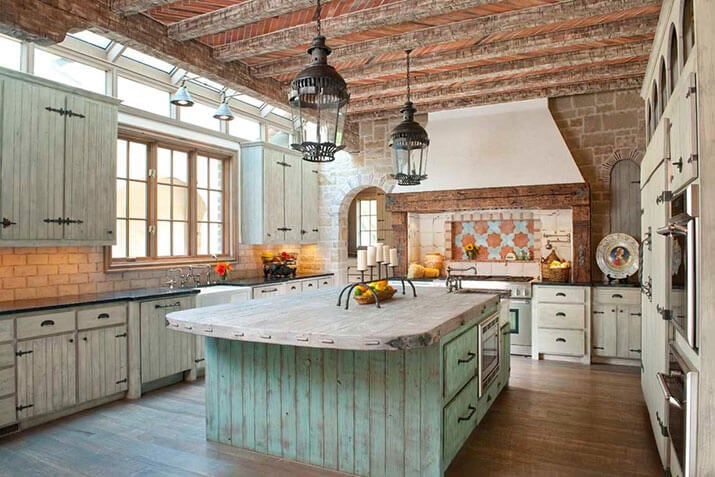
One of the most distinctive elements of a Mediterranean kitchen design is the use of bold colors used throughout the space to create an eclectic aesthetic. Naturally weaving together vibrant shades of teal blues and greens contrasted with rustic reds, rich yellows, and earth tones, the colors of the Mediterranean are sure to excite both you and your guests. The best part about the bold use of color is that there aren’t any particular rules you need to follow when designing your dream kitchen. If you’re craving an eclectic backdrop of color for your kitchen’s cabinet, you don’t need to settle for a neutral color palette. From the larger design elements like cabinets and backsplash to the smaller features like rugs and glassware, there are plenty of ways to incorporate a plethora of terra cotta tones, ocean blue hues, and other spectacular colors.
Natural Elements

Instead of a cookie-cutter kitchen with white countertops, white kitchen cabinets, and white subway tile, the Mediterranean design looks to incorporate not only bold color choices but natural elements for a sense of character and charm. Consider installing hardwood floors in a natural wood hue paired beautifully with natural light and a unique backsplash composed of hand-painted tiles. Finding ways to add in earthy design elements is the perfect way to elevate your Mediterranean kitchen design.
Tile Backdrop

Like most kitchen designs, tiles are used to create a beautiful focal point as the kitchen backsplash. In more modern kitchens, you’re likely to find intricate glass tile or subway tile, while a Mediterranean kitchen often opts for terra cotta or mosaic tile. Think of your kitchen backsplash as another way to add a pop of color to the space. Whether you install hand-painted tile with intricate design work, arrange your tile in a unique pattern, or choose a charismatic color choice, there are many ways to create a focal point with your tile backdrop. You may even decide to incorporate a more traditional Mediterranean look that features mosaics placed in intricate patterns that depict the culture of the Mediterranean such as a seascape.
Wood Furniture
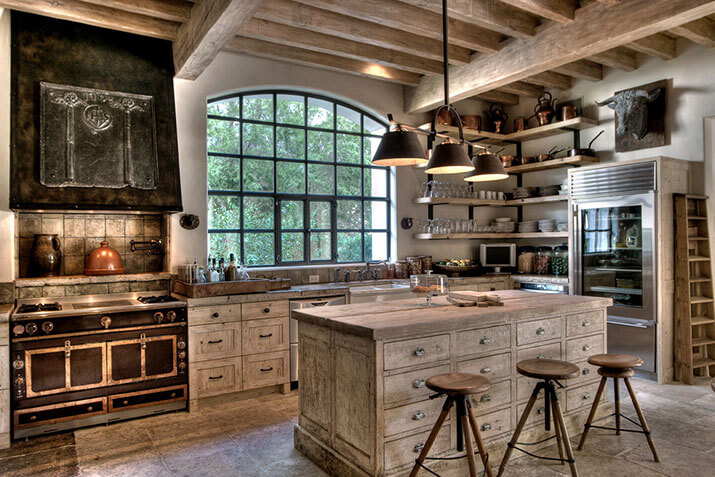
The Mediterranean aesthetic celebrates the use of natural, weathered materials that have a natural beauty and charm, unlike more traditional or contemporary kitchen design elements. Find ways to add weathered wood pieces that are one-of-a-kind to your kitchen to really hone in on the relaxed nature of the Mediterranean. Consider incorporating wood bar stools that are in a natural, unfinished state or open shelving made of weathered wood slabs into the room. If you’re not a fan of natural-looking wood, you can even opt to paint these pieces in Mediterranean colors as a way to add more vibrance to the space.
Charming Lighting
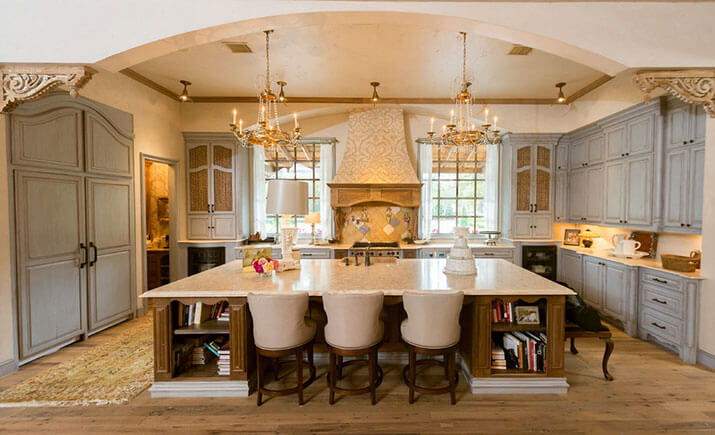
Although lighting may not seem like a crucial design element, it can make or break your Mediterranean design if not done properly! Instead of going with classic recessed lighting, we love the look of installing a wrought iron chandelier in a stunning bronze tone above your kitchen island as a focal point that is reminiscent of old-world charm. Along with the wrought iron chandelier, you can install wrought iron pendant lights that tie in beautifully with the chandelier but add in their own sense of flair for the kitchen’s task and accent lighting.
Texture
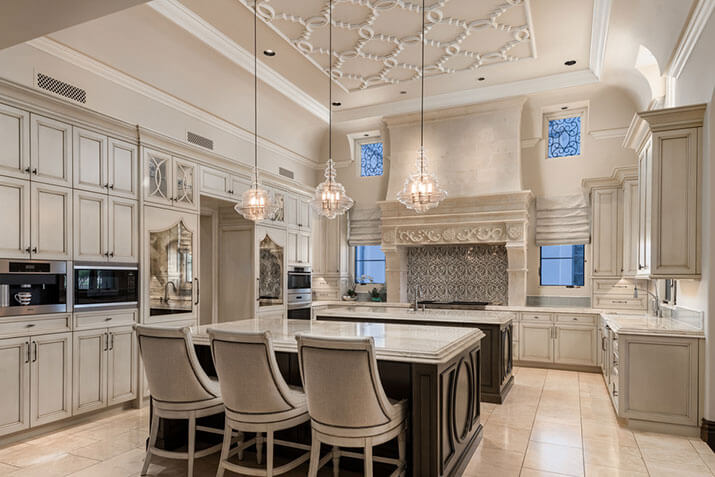
A Mediterranean kitchen design is anything but boring. It evokes a rustic and earthy vibe that makes you feel as though you are one with nature. To create this sense of unmatched charm, Mediterranean styles incorporate a variety of textures throughout the space from plaster-finished walls and mosaic backsplashes to terra cotta tile countertops. The addition of texture creates movement throughout the space that helps draw your eye around the room to admire each element individually and as a whole. Find ways to enhance the old-world charm aesthetic by incorporating texture in multiple parts of your kitchen design.
Architectural Charm
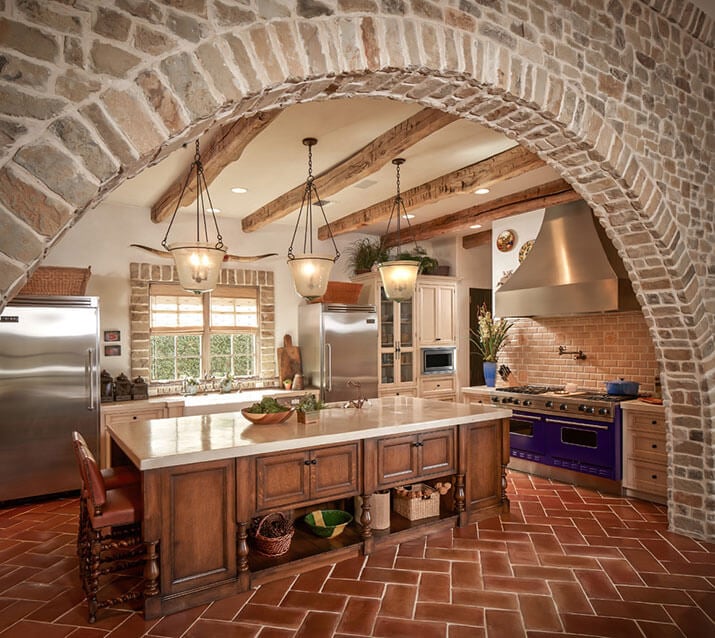
While straight, clean lines are often the sought-after look in most kitchen designs, Mediterranean kitchens seem to have a mind of their own! Along with the style’s unique texture and color palette, you’ll also find curvy and swooping architectural designs, unlike anything you’ve ever seen before. These graceful curves help tie the entire space together by adding fluidity to the room and creating a softer design.
Frequently Asked Questions
What are Mediterranean colors?
A distinctive characteristic of the Mediterranean style is its vibrant color palette. Incorporating warm and earthy hues, you’ll often find colors such as terra cotta, chestnut, and ochre throughout the design. To beautifully compliment these earthy tones, the design will include colors reminiscent of the sea and sky, such as teal, seafoam green, and azure.
What is the difference between Tuscan and Mediterranean?
Tuscan and Mediterranean styles are often thought to be unanimous, but that’s not the case. While they pull from influences, the Tuscan style is derived from Italian influences while the Mediterranean design style incorporates a blend of cultures, such as Spain, France, Morocco, Turkey, and Greece.
What are the major architectural features of Mediterranean design?
Along with swooping architectural designs, you’ll also find that Mediterranean designs often incorporate large windows to let in ample natural light. These large windows are reminiscent of the balconies and terraces found within old-world Mediterranean architecture.
How do I keep a Mediterranean kitchen from feeling dark?
If your kitchen suffers from a lack of natural light, you may be looking for some alternatives to keep the light flowing evenly through the space. While you may not be able to add in more natural light, you can install additional wrought iron pendants for task or accent lighting. You may also want to consider installing open shelving instead of upper kitchen cabinets to lighten up the room and make it feel more open.
![See your dream kitchen in 3D [GET YOUR FREE DESIGN]](https://cdn.kitchencabinetkings.com/blog/wp-content/uploads/see-your-dream-kitchen-in-3d.webp)
![Contractor Discount Program: Offering contractors and builders special volume discounts on all applicable orders [LEARN MORE]](https://cdn.kitchencabinetkings.com/blog/wp-content/uploads/contractor-discount-program.webp)
![Explore our photo gallery [GET INSPIRED]](https://cdn.kitchencabinetkings.com/blog/wp-content/uploads/explore-our-photo-gallery.webp)
![What everyone is saying about KCK [READ REVIEWS]](https://cdn.kitchencabinetkings.com/blog/wp-content/uploads/what-everyone-is-saying-about-kck.webp)
![Get a cabinet sample [SHOP SAMPLES]](https://cdn.kitchencabinetkings.com/blog/wp-content/uploads/get-a-cabinet-sample.webp)
![Pay over time, on your terms with Affirm [LEARN MORE]](https://cdn.kitchencabinetkings.com/blog/wp-content/uploads/pay-over-time-on-your-terms-with-affirm.webp)